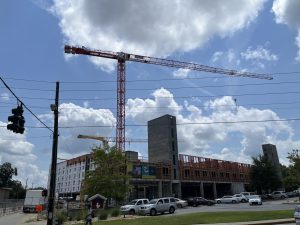Struggles in accessibility: how GS helps support students with disabilities
April 11, 2017
It has been over 25 years since the Americans with Disabilities Act (ADA) became law, prohibiting discrimination because of disability. Since then, there have been many strides made to make mobility less of an issue for people who use wheelchairs or scooters to go about their daily life.
Here at Georgia Southern, strides have been made here as well to help students with disabilities feel more comfortable as they go to their classes, get on buses or live in a residence hall.
What’s the ADA?
The ADA is an act that was passed on July 26, 1990. The goal of this law was to protect individuals who have disabilities and allow them to obtain a job, going into buildings and other things without discrimination.
Examples of disabilities covered by the ADA are physical disabilities such as cerebral palsy, medical disabilities like diabetes, psychiatric disabilities like depression, learning disabilities like dyslexia, developmental disabilities like autism and finally, alcohol and drug addiction.
The ADA contains five sections all called titles.
Title I: Employment
Most employers aren’t allowed to discriminate against an employee due to their disability. These employers are called “covered entities”.
Places like employment agencies, labor organizations and employers with 15 or more workers have to follow ADA rules. As long as a person is qualified and able to do their job, these places cannot discriminate.
GS is considered a “covered entity” and has many resources for students with disabilities to take advantage of. One such resource is the Student Disability Resource Center, or SDRC.
The SDRC
SDRC is the most recognizable place for students to go. Located in the second floor of Cone Hall, the SDRC is home to test proctoring rooms, assistive technology equipment and more.
“There’s so many different things to think about and you never have the same day twice,” Deborah Perez-Lopez, Director of the SDRC said. “There’s a lot of things to consider.”
Between 600 to 700 students on GS’ campus, or three percent of the full population, are assisted in some way by the SDRC, whether it be providing note takers to help supplement their own notes or other ways, according to Perez-Lopez.
According to Perez-Lopez, middle schools and high schools have different approaches than colleges when it comes to students with disabilities.
“They’re sort of required that the student actually succeeds and they are able to modify certain things in the curriculum to that end, but that is not the case at this level,” Perez-Lopez said.
In college, students are ensured the opportunity as well as equal access, but that doesn’t mean that students will receive A’s.
Title II: State and Local Government Activities and Public Transportation
Title II protects against discrimination within state and local governments. If a person with a disability requires accommodations to participate in programs or activities, the local or state government must make them, under ADA.
People must be allowed to go to public schools, have health care, use social services and more. In addition to this, people with disabilities must be able to use public transportation such as buses and trains just like an able bodied person.
All of Georgia Southern’s buses are wheelchair accessible. If a person requires help to get on the bus, the bus driver with stop the bus, lower it and release a ramp for the person to wheel up on, helping them up if necessary.
Title III: Public Accommodations
Title II protects against public accommodation discrimination, in places such as restaurants, museums and hotels. This also includes all of the residence halls on Georgia Southern’s campus.
University Housing
For those who live in on-campus housing, ADA accessibility has become an issue. Although each on campus dorm has levels that are ADA accessible, they are limited.
Fortunately, improvements are underway as Peter Blutreich, Executive Director of Housing explains, but they will take time.
“I would say that it is important to meet the needs of students. Each student requesting accommodations has unique and individual needs which are addressed through conversations between the student, the SDRC and the Housing Office,” Blutreich said. “We work regularly with students on a one-on-one basis to discuss their needs and to come up with solutions that can work.”
University Housing has worked to increase options for those who request it, but also understand that it is not as easy as it may seem. Beyond creating greater ADA options, plans for renovations have to be made.
On top of that, one must be able to accommodate the individual regarding their needs and in that, they must work with multiple organizations and groups that may help in meeting the needs of those who need it the most.
For those who live or have lived in a dorm before, they have witnessed the small amount of ADA accessible areas in the dorms. For junior writing and linguistics major, Jayla Shockley, has lived in two dorms during her college career, she hasn’t seen much ADA accessibility around.
“I think that they may have access on the first floor, but they don’t have any way of getting upstairs. We don’t have any escalators or elevators,” Shockley said. “I think that they should provide ramps instead of stairs. It would make it easier to move around.”
Title IV: Telecommunications
Title IV protects against discrimination by telecommunications companies like phone companies. These companies must have services like relay services, where a phone operator is able to help a person with a hearing or speaking disability use a regular phone.
These type of services have to be available 24 hours a day.
Title IV: Miscellaneous
Finally, Title IV protects individuals with disabilities with miscellaneous rules. Nobody is allowed to be punished for helping somebody access their ADA rights or helping somebody use their rights.








